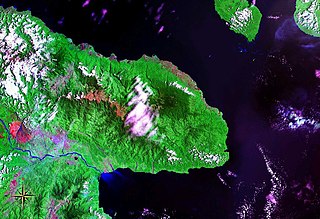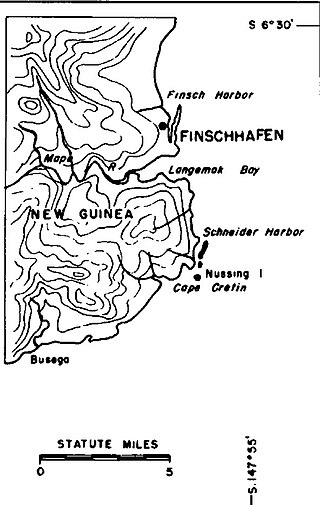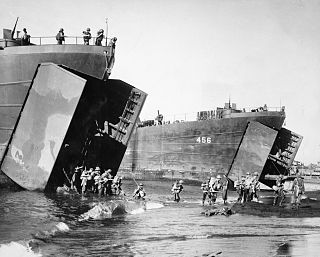Lae (German: Preußen-Reede, later Lehe) is the capital of Morobe Province and is the second-largest city in Papua New Guinea. It is located near the delta of the Markham River and at the start of the Highlands Highway, which is the main land transport corridor between the Highlands Region and the coast. Lae is the largest cargo port of the country and is the industrial hub of Papua New Guinea. The city is known as the Garden City and home of the University of Technology.

Morobe Province is a province on the northern coast of Papua New Guinea. The provincial capital and largest city is Lae. The province covers 33,705 km2, with a population of 674,810, and since the division of Southern Highlands Province in May 2012 it is the most populous province. It includes the Huon Peninsula, the Markham River, and delta, and coastal territories along the Huon Gulf. The province has nine administrative districts. At least 101 languages are spoken, including Kâte and Yabem language. English and Tok Pisin are common languages in the urban areas, and in some areas pidgin forms of German are mixed with the native language.

Huon Peninsula is a large rugged peninsula on the island of New Guinea in Morobe Province, eastern Papua New Guinea. It is named after French explorer Jean-Michel Huon de Kermadec. The peninsula is dominated by the steep Saruwaged and Finisterre and Cromwell Mountains. The nearest large town is the Morobe provincial capital Lae to the south, while settlements on the north coast include the former German town of Finschhafen, the district capital of Wasu, Malalamai and Saidor with its World War II era Saidor Airport.

Officially named Nadzab Tomodachi International Airport, Nadzab Airport is a regional airport located at Nadzab 42 kilometres (26 mi) outside Lae, Morobe Province, Papua New Guinea along the Highlands Highway. It is served by both private and regional aircraft with domestic flights. The airport replaced the Lae Airfield in 1977.

Finschhafen is a town 80 kilometers (50 mi) east of Lae on the Huon Peninsula in Morobe Province of Papua New Guinea. The town is commonly misspelt as Finschafen or Finschaven. During World War II, the town was also referred to as Fitch Haven in the logs of some U.S. Navy men.

The Landing at Lae was an amphibious landing to the east of Lae and then the subsequent advance on the town during the Salamaua–Lae campaign of World War II. Part of Operation Postern, which was undertaken to capture the Japanese base at Lae, the landing was undertaken between 4 and 6 September 1943 by Australian troops from the 9th Division, supported by US naval forces from the VII Amphibious Force. The first major amphibious operation undertaken by the Australian Army since the failed Gallipoli Campaign, the Australians invested a significant amount of effort into planning the operation.
Nadzab Village is in the Markham Valley, Morobe Province, Papua New Guinea on the Highlands Highway. Administratively, it is located in Gabsongkeg ward of Wampar Rural LLG. The Nadzab Airport is located East of Nadzab Village and was the site of the only Allied paratrooper assault in New Guinea on 5 September 1943.

Lae Airfield is a former World War II airfield and later, civilian airport located at Lae, Morobe Province, Papua New Guinea. The airport was closed in the 1980s, in favour of Lae Nadzab Airport, which was able to accommodate larger jet aircraft. The airport was also known as Lae Drome or Lae Aerodrome.

The Malahang Mission Station is a Lutheran filial station situated in Malahang, Morobe Province in Papua New Guinea now under the auspices of the Evangelical Lutheran Church of Papua New Guinea. The Mission station is located on Busu Road, Malahang opposite the Malahang Industrial Area.

Butibam is a village on the outskirts of Lae, Morobe Province in Papua New Guinea.
Omili is a suburb of Lae in the Morobe Province, Papua New Guinea.
Bumayong is an outer suburb of Lae in the Morobe Province, Papua New Guinea.

Situm is a government ex-servicemen block outside of Lae in Labuta Rural LLG, Morobe Province, Papua New Guinea.
Voco Point is a suburb of Lae in the Morobe Province, Papua New Guinea. Voco Point is one of the busiest coastal trading points in the country and coastal vessels from throughout the country, from Alotau to Manus, from Lihir to Vanimo line up at the wharves. The passenger boats ferry people to Finschhafen, the Siassi islands, Kimbe, Rabaul, New Ireland, Oro Bay, Alotau, Madang, and Wewak. The local Lae villages call the area around Voco Point Asiawi, which according to mythology, used to be a long point that went out much further but was eaten by the evil spirit Yaayaa.
Chinatown is a suburb of Lae in the Morobe Province, Papua New Guinea.
Bumneng is a suburb of Lae in the Morobe Province, Papua New Guinea.
Eriku is a suburb of Lae in the Morobe Province, Papua New Guinea.

As the township of Lae, in Morobe Province, Papua New Guinea is a relatively new entity, the history of the Lae environs is much older.

ANGAU Memorial Hospital is a major hospital in Lae, Papua New Guinea. Named after an Australian Army unit that was responsible for the civil administration of the Territory of Papua and the Mandated Territory of New Guinea, the hospital provides in-patient and specialist medical services to people in the Sepik, Madang and Morobe provinces. In 2013–14, the Australian government announced that it would contribute to the hospital's redevelopment as part of a deal with the PNG government relating to the resettlement of asylum seekers.
The Hopoi Mission Station is a Lutheran filial station situated in Morobe Province in Papua New Guinea now under the auspice of the Evangelical Lutheran Church of Papua New Guinea.


















